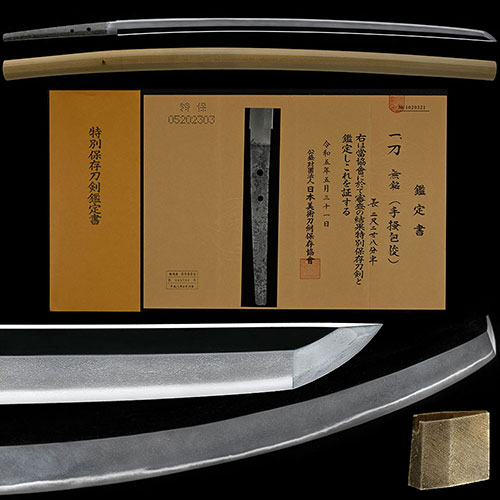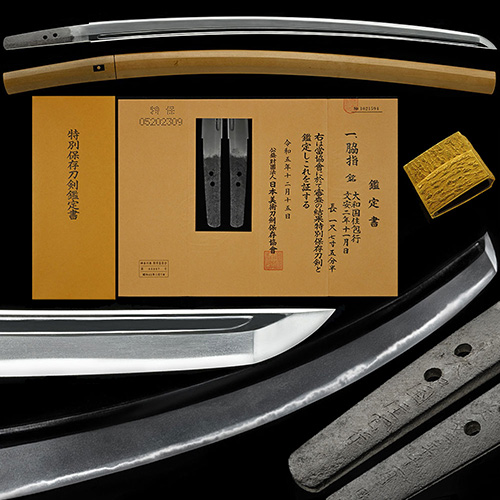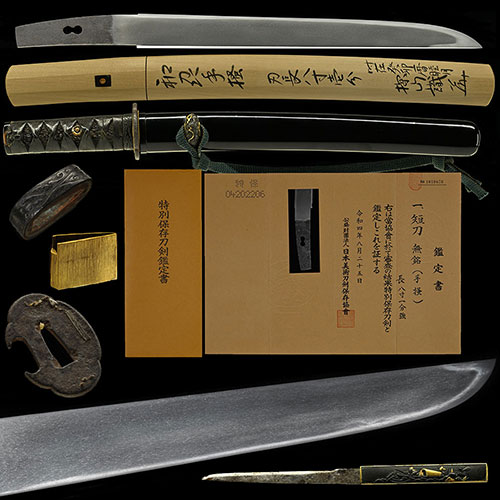
手掻包俊 太刀Tegai Kanetoshi Tachi
No.605520手掻包俊 生ぶ茎太刀 南北朝時代永徳頃 約640年前 精良な地鉄に直刃映り立ち地刃明るく冴える優品 二尺二寸六分Tegai Kanetoshi Ubu Nakago Tachi Around Eitoku during the Nanbokucho period, 640 years ago, Utsuritachi, Jiba is bright and clear, A masterpiece 68.4cm
- 極めKiwame
- 手掻包俊Tegai Kanetoshi
- 登録証Registration
- 新潟県 Niigata 平成15年4月18日 4/18/15(Heisei)
- 時代Period
- 南北朝時代Nanbokucho period
- 法量Size
-
刃長 68.4cm (二尺二寸六分) 反り 0.7cm
元幅 2.8cm 先幅 1.8cm 元重 0.55cm 鎬厚 0.62cm 先重 0.43cm 鋒長 2.5cm 茎長 20.9cm 重量 598gHachou 68.4cm (二尺二寸六分) Sori 0.7cm
Moto-Haba 2.8cm Saki-Haba 1.8cm Moto-Kasane 0.55cm Shinogi-Thikess 0.62cm Saki-Kasane 0.43cm Kissaki-Chou 2.5cm Nakago-Chou 20.9cm Weight 598g - 国Country
- 大和Yamato
- 姿Shape
- 鎬造、庵棟、身幅尋常、反りやや浅く、中鋒。Shinogidukuri, Iorimune, Standard Mihaba, Slightly shallow Sori, Chu-Kissaki.
- 鍛Kitae
- 小板目肌つみ、杢目・柾目肌交じり、地沸微塵に厚くつき、映り立ち、鉄冴える。Small-Itamehada-tsumi, Mokume, Mixed Masamehada, Jinie entered fine and thick, Utsuritachi, Iron is clear.
- 刃文Hamon
- 中直刃に、湯走り・食違い掛り、小足細かく入り、小沸よくつき、匂口明るく冴える。Chu-Suguha, Yubashiri, Kuichigai-kakari, Small-Ashi entered finely, Small-Nie entered well, Nioikuchi is bright and clear.
- 帽子Boushi
- 金筋掛り、直に小丸、先掃きかける。Kinsuji, Sugunikomaru, Sakihakikakeru
- 茎Nakago
- 生ぶ、先切、鑢目筋違、目釘孔二。Ubu, Sakikiri, Yasurimesujikai, Mekugiana are two(2)
- ハバキHabaki
- 銀無垢一重。Solid silver single layer.
- 説明Drscription
- 手掻派は東大寺に隷属した刀工集団で、東大寺転害門の門前に住していたことから、手掻(てがい)と呼称されるようになった。鎌倉後期正応(1288)頃の包永を祖とすると伝え、正宗十哲の兼氏も手掻派に属したといわれている。包俊は、二代包永三男の包行門と伝え、南北朝時代永徳頃に活躍している。この刀は、身幅尋常、反りやや浅く、中鋒となる生ぶ茎の小振りな太刀で、つんだ小板目肌に柾目を交え、湯走り・食い違い掛り、地鉄がよく冴えるなど手掻の特色がよく表われ、匂口明るく冴える優品である。The Tegai faction is a group of swordsmiths who were enslaved to Todaiji Temple, and since they lived in front of the Todaiji Temple's Tegai Gate, they came to be called Tegai. It is said that Masamune Jittetsu's Kane-san also belonged to the Tegai faction, saying that he was the ancestor of Kanenaga around the middle of the Kamakura period (1288).
Kanetoshi is said to be Kaneyukimon, the third son of the second Kanenaga, and was active around Eitoku during the Nanbokucho period.
This sword is standard Mihaba, Slightly shallow Sori, Ubu-Nakago's small Tachi that becomes Chu-Kissaki, Tsunda-Small-Itamehada with mixed Masame, Yubashiri, Kuichigaikakari, The characteristics of tekaki are clearly expressed, such as the sharpness of Jigane. It is an excellent product with a bright and clear Nioikuchi.







